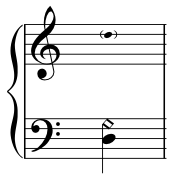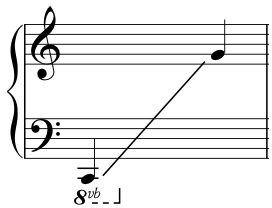Double Octave Harmonics
Fourth partial harmonics are usually called double octave harmonics among harpists. The name refers to the resulting sound of two octaves above the fundamental.
Production
The string is stopped with the knuckle or the side of the hand at a point that is exactly 3/4 of the string's total length away from the soundboard. The thumb plays the upper 1/4 of the string. As the thumb plays the string, the knuckle or the side of the hand leaves the string, letting it resonate.
Sound
Double octave harmonics sound quite soft and are not as clear as other harmonics.
Notation
Double octave harmonics are notated with a little diamond placed a fourth above the played note. The resulting note sounds two octaves higher. To avoid confusion it is helpful to write the sounding pitch in parentheses above the note the first time such a harmonic occurs.

Double octave harmonic.
Range
The lower half of the harp's range, with its long strings, is optimal for producing double octave harmonics.

Range for double octave harmonics.
N.B. Harmonics in the lowest octave of the harp sound soft and rather undefined.